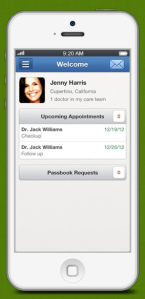When Google Health first went live in 2008, the service held a lot of promise for people looking for a reliable and convenient way of centralizing their health records, and then matching them up with other resources like drug information and doctor databases. But when, in 2011, Google decided to shutter the service after it didn’t pick up enough traction, that left a lot of people with a challenge: abandon ship or look for a new place to fight the e-health fight. They had a bit of time to decide: Google said that it would only delete all remaining records on the service on January 1, 2013.
Enter onpatient: a new public health record service from drchrono, a Y-Combinator alum with backing also from Yuri Milner, Matt Cutts, Paul Buchheit, General Catalyst Partners, Charles River Ventures, 500 Startups and Start Fund.
Its initial goal is simple. It wants to be a replacement for Google Health: “Our goal is to allow everyone using Google Health to import their data into onpatient,” co-founder Daniel Kivatinos wrote in an email earlier today.
But while replicating what Google did with Google Health might be an impressive feat in itself, ultimately that might not do any better than Google Health did in the market. Kivatinos and his co-founder Michael Nusimow have been honing drchrono for the last four years and now has 34,000 doctors listed.
The pair had always wanted to integrate with Google Health when it was still a going concern, “but the service was missing some key features and we wanted to integrate once those features were there.” Those included a lack of customizable forms for different physicians, the ability to send picture messages to help decide whether a medical issue is serious enough to merit a trip into the doctors’ office. “Google Health was missing that real-time feedback.”
Other problems were perhaps just a sign of the market not yet being ready.
“It was somewhat hard for people to share their information from Google Health with their doctor,” said Kivatinos. “If a person is using an iPhone, they can use onpatient on their iPhone, have the doctor to scan a Passbook QR code, and the doctor will be given access to the medical record once verified.”
Then, when the two heard Google Health was shutting down, “Michael and I decided it was time for our team to build the replacement, rolling in features that we thought Google Health was missing. Patients should be able to connect with their doctor or care team.”
Onpatient is not a distinctly unique business: there are at least two other providers out there already offering to important Google Health data into their own systems: MyMediConnect has been around for about a year and accepting Google Health records; and Microsoft has its HealthVault. In fact it’s the HealthVault that Google itself recommends to displaced users of its discontinued product.
So drchrono has taken its Google Health replacement a couple of steps further. “This is one of the most impressive pieces of software we have built to date,” says Kivatinos. “We are taking over what Google Health was doing and enhancing it, allowing people to manage their health data in one place.”
Rather than using onpatient as a place to pool records created by other people, drchrono puts a strong emphasis on primary data recorded by the patients themselves, by way of smartphones and apps (“mobile phones are the perfect for recording health data and sharing this data back to a doctor,” Kivatinos explains; the app is iPhone only right now); diagnostic cuffs, and more to come apparently. The data that gets collated is then used to find doctors, schedule appointments, send secure messages between patients and professionals, track health spend, and more.
Because drchrono already provided some of these services — its existing business is in electronic health records for doctors and medical practices — it’s using its existing base as the first port of call, and so onpatient launched today with 1.3 million people already on its books.
Kivatinos notes that for now the app is free for consumers, with drchrono generating revenue at the doctor end — individuals can only link records to doctors who have signed up for the service; doctors will only have access to certain features depending on whether or not they have taken a paid a monthly fee. Those features include medical speech to text, bidirectional labs, faxing, medical billing, electronic e-prescribing and advanced support/training.
